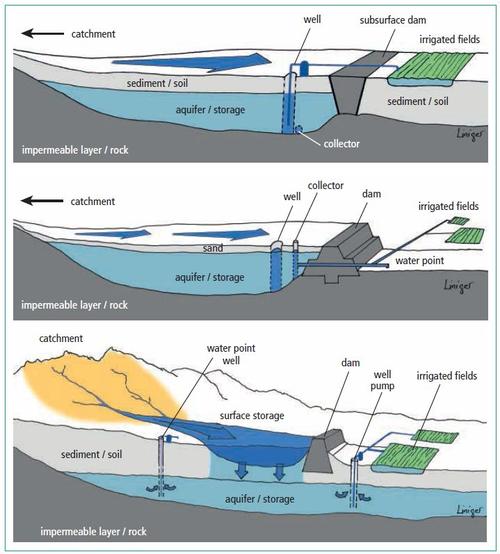Groundwater dams / retention weirs
Groundwater dams obstruct the flow of groundwater and store water below ground level and replenish the wells upstream of the dam. There is a wide variety of different types of ground water dams also called retention weirs:
Subsurface dams are built entirely underground into sandy riverbeds of seasonal water courses and founded on impermeable bedrock to intercept groundwater flow. They are impermeable barriers (clay, masonry or concrete) obstructing subsurface flow. Groundwater can be abstracted through wells, boreholes or a collector drain. Typical small dams have a storage capacity of some 10,000 m3 (average 4 m depth, 50 m width and 500 m length). Larger dams may be 5 – 10 m in depth, have a width of 200 – 500 m or more, and be able to store 100,000 – 1,000,000 m3. Several dams built in a cascade increase the total groundwater volume stored and limit the effects of leakage. Sub-surface dams reduce variation in the level of the groundwater table upstream of the dam. They are found in many countries in different sizes and numbers.
Sand dams are larger than subsurface dams and weirs as they can be raised to several meters above ground in sandy riverbeds. Coarse sand carried by the flow is deposited upstream of the dam and gradually fills the streambed while lighter material is carried over it in periods of high flow. Water is stored within the porous space of the deposited coarse sand. This artificial aquifer increases in thickness over time. Additionally, the sand reduces evaporation and contamination of the water in the sand body behind the dam rendering the water suitable for livestock, domestic supply or small-scale irrigation.
Percolation dams do not block ground water flow as the previous systems. They serve three purposes: (a) to reduce the speed of surface flow; (b) increase percolation for the recharge of shallow aquifers; and (c) obstruct the flow of sediments. They are constructed across riverbeds, natural drainage channels and gullies. Simple check dams are made of natural materials that are locally available such as rocks, logs, bamboo, sticks and branches. More sophisticated dams are constructed using rocks and steel rods (gabion). Concrete is used for making permanent check dams but the foundation of the dam wall does reach the impermeable layer. Crops are irrigated by pumping water from recharged wells. In Thailand they are used for reforestation.
Subsurface dams, sand dams and percolation dams can be combined. The storage volume can be increased by raising the dam wall above the surface, thus causing additional accumulation of sediments. Ideal riverbeds for the construction of such groundwater dams consist of sands and gravel, with rock or an impermeable layer at a few metres depth. Preferably, the dam should be built where rainwater from a large catchment area flows through a narrow passage. Such underground reservoirs can be filled by a single flash flood. Once saturated, the remaining water will pass over the dam and replenish downstream aquifers. Water is extracted for use either manually from wells or with motorized pumps. (Mekdaschi & Liniger 2013)
